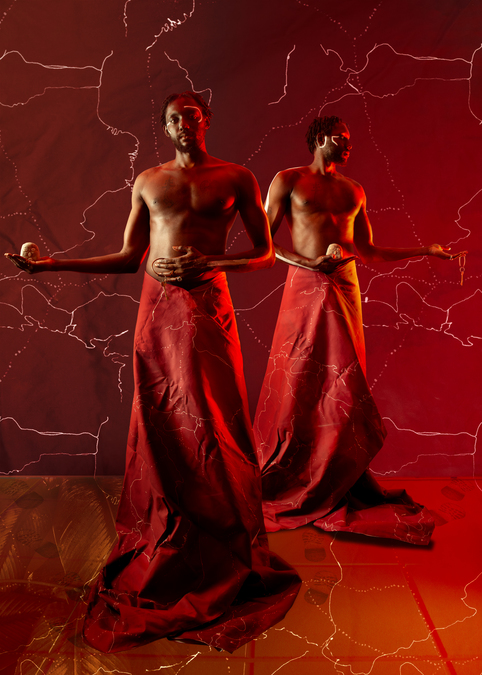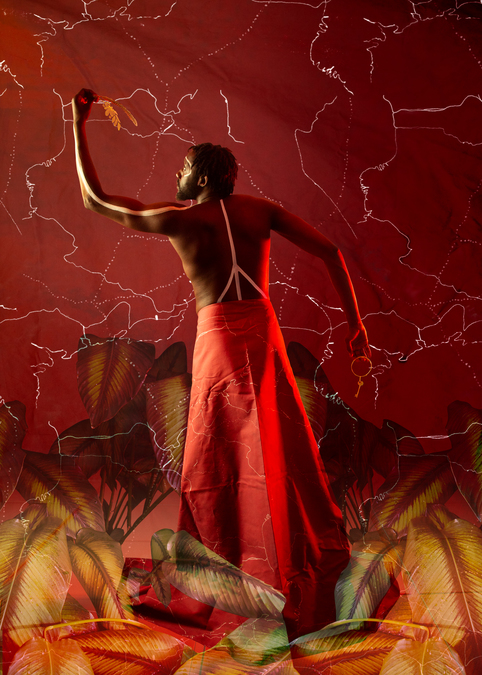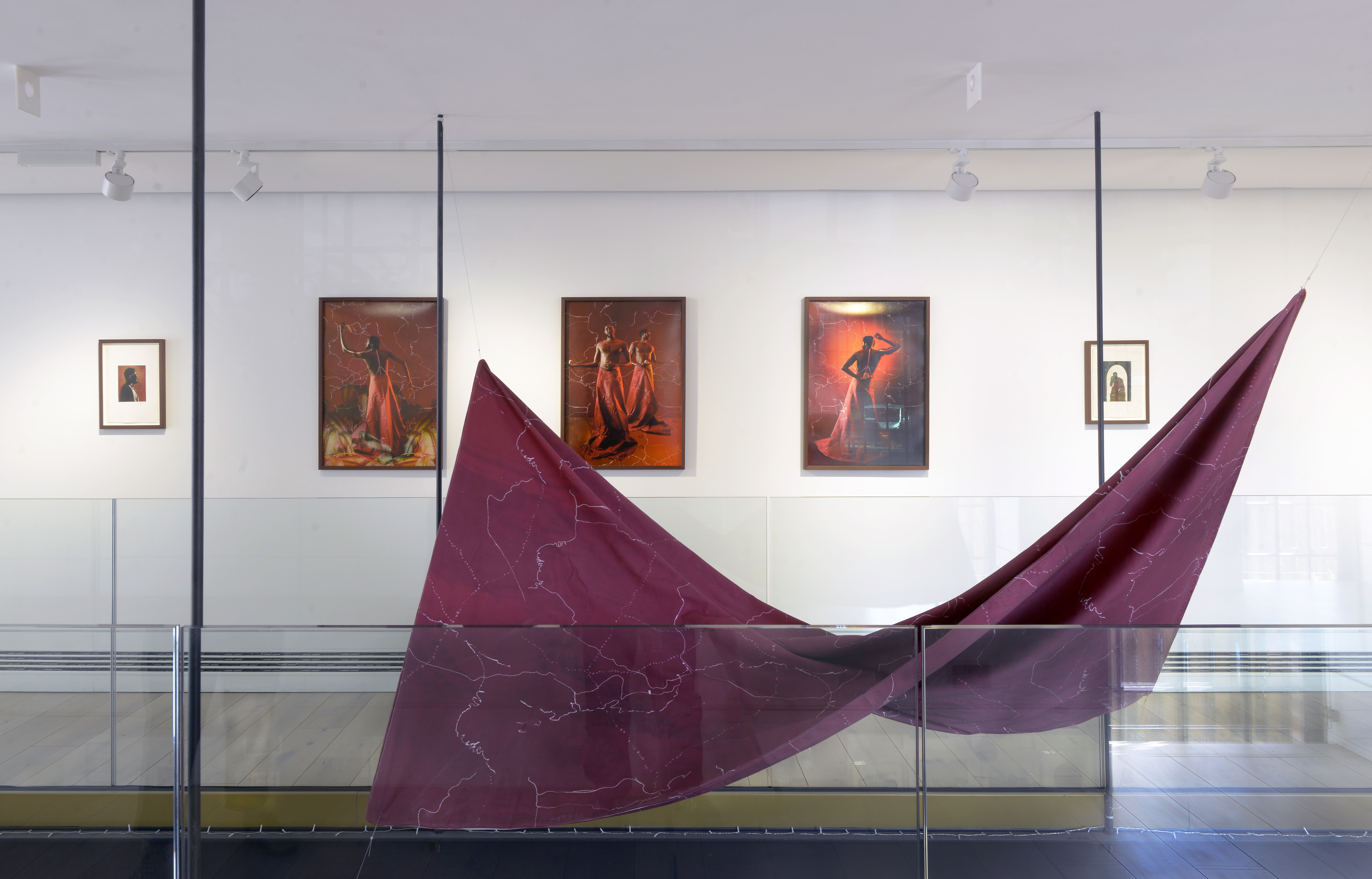The Power of the Unseen: Tayo Adekunle at Edinburgh Printmakers
In her show at Edinburgh Printmakers, Tayo Adekunle finds affinity with a Yoruban Orisha in new photographs, prints and textile works
In traditional Yoruba spirituality, Éṣù – as the guardian of gateways and crossroads – exists between two realms. “He's the divine messenger, and he's the intermediary between the rest of the Orishas [divine spirits] and humans. So anytime you want to talk to one Orisha, you'll usually give an offering to Éṣù as well,” says Nigerian-British artist Tayo Adekunle.
In Stories of the Unseen at Edinburgh Printmakers, Éṣù takes centre stage. Unpacking racial history and its colonial violence, Adekunle’s work seeks to subvert the dominant narratives told of Black people and Black culture. The exhibition spotlights Adekunle’s new work, developed through her residency at Edinburgh Printmakers, as well as previous works Reclamation of the Exposition and Artefact series (2020) which explores the commodification and fetishisation of Black women’s bodies in the 18th and 19th century.
“I felt a serious affinity with [Éṣù],” Adekunle says. He appears in her recent prints in red hues beneath curved gold, holding each photographed frame with a balanced grace. Arms at angles, reaching, are coupled with a warm expression of wisdom. When Christian missionaries translated the Bible into Yoruba, Éṣù – a little bit of a trickster, keen to test individuals – was misused as a translation for the devil. Colonisation continues to grip language and stories all too tightly; Éṣù’s name is still bound to a certain evil, a wretchedness. Adekunle, therefore, wanted to shine a light on this misrepresentation, instead presenting Éṣù in all his glory. “Being a Black woman, people just make their mind up about me quite quickly – and I can see it.”
Adekunle’s residency at Edinburgh Printmakers saw her printing for the first time since college. “Basically, I try to do everything myself, which is kind of a good thing and a bad thing,” she says. Making her own props, sourcing her own archival material, and acting as her own model, Adekunle’s practice sees each aspect of the work tell its own story. “It means that it's quite meditative, but this [residency] really, really slowed everything down. It was glorious.” Toyobo printing, which Adekunle used throughout her residency, sees photosensitive plates exposed to digital images, allowing the plates to print etchings. Layers press upon layers; a story is told and re-told.
Install view of Stories of the Unseen, Tayo Adekunle. Image courtesy of the artist. Photo by Alan Dimmick.
In the middle of the exhibition, a single fabric hangs, twisted. Maps of Africa – from pre-colonial to the present – span across it. “I wanted that piece to be multi-purpose so I used it as a backdrop, and then I also used it to drape over the model. I also wanted to have it in the show,” Adekunle says. After designing the print herself, GSA’s Centre for Advanced Textiles printed it upon the fabric. In her previous work, Adekunle used different Nigerian fabrics, lovingly sent by her mother. She photographed them, used them as backdrops, and, sometimes, simply wore them. It was fitting, then, to bring such versatility – draping, hanging, twisting – into this new body of work.
Although she is usually both model and photographer, this residency saw Adekunle stay behind the camera, with a friend of hers modelling the figure of Éṣù. “I’ve struggled,” she laughs. With so much of her previous work unpacking the power of the photographer – particularly in relation to the portrayal and agency of Black people – she found herself routinely checking that the model was comfortable. She needn’t have worried: after the first day of the two day shoot, the model went home with the body paint on, enjoying the lines and curves upon their face, their back. “I love that,” says Adekunle.
“I think that images are quite powerful in communicating ideas. I was finding all of these things in academic sources that most people aren't going to read. It also doesn't carry the weight of the thing,” she says. Too much of our history is held – contained, sanitised – in academia rendering it unreachable to most. The well-worn phrase prevails: knowledge is power. Understanding the roots of our present-day injustices is critical in working through them. There's so much history that isn't told or is ignored, and people and figures who are just completely disregarded,” she says. And so, Adekunle is keen to take our stories into the open. Her work holds cataclysmic possibilities, presenting a figure or a pattern, an object or an idea, and encouraging the viewer to seek more of the story elsewhere. “For me, storytelling is a form of history. We have a history that's in textbooks, but that is also a form of storytelling.” Fact, fable – these are false categories for historical understanding, too often dictated by the white powers that be.
“The remnants of a true history that we have are from folk tales and oral history,” says Adekunle. Éṣù’s tale was seized by colonial ideals, manipulating his character beyond recognition. Appearing in Stories of the Unseen as both a healer and a guardian, Adekunle reclaims his story for all to witness. “It’s a radical act to fight to keep your culture alive.”
Stories of the Unseen: Tayo Adekunle, Edinburgh Printmakers, until 10 Nov


